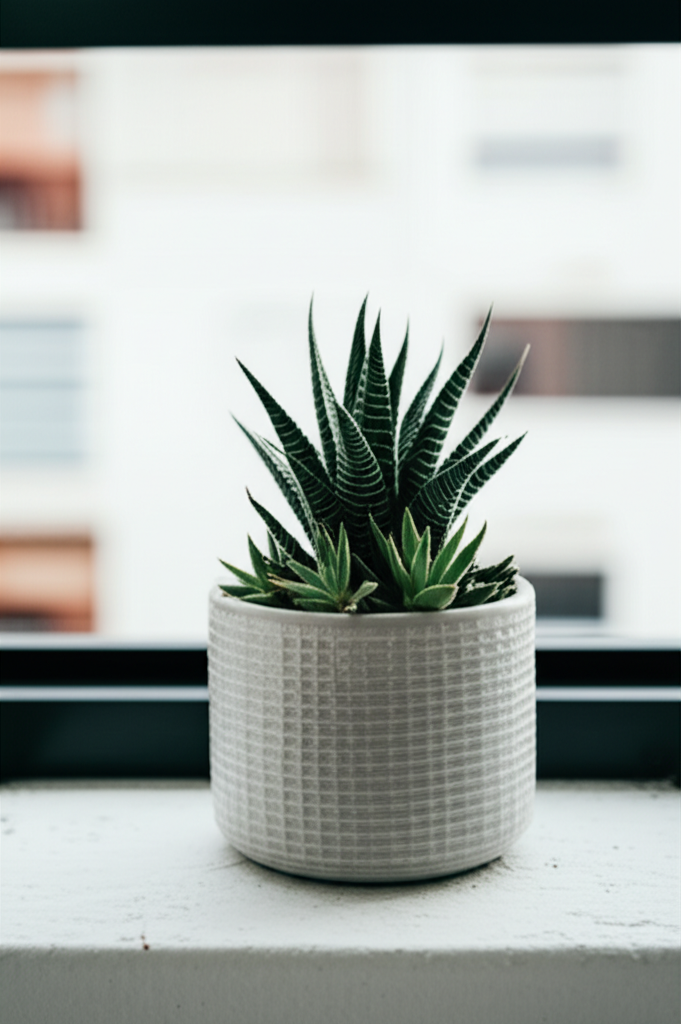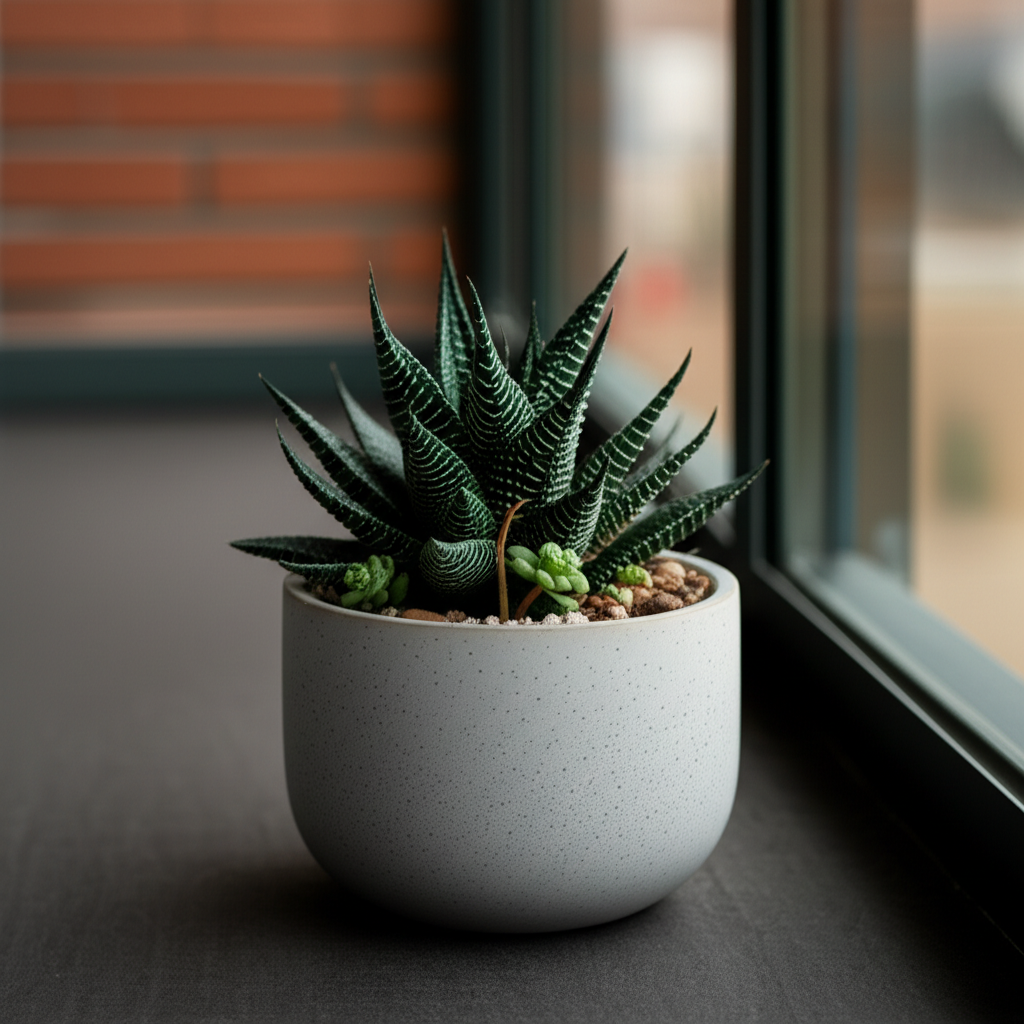Introduction: Bringing the Desert Bloom Indoors
For those with limited outdoor space but a yearning for vibrant, low-maintenance greenery, the humble ice plant succulent offers a captivating solution. These fascinating plants, scientifically known as Delosperma, are renowned for their daisy-like flowers that shimmer with a dew-like sparkle, reminiscent of frost or, indeed, ice. Their succulent nature means they store water efficiently, making them remarkably drought-tolerant and ideal for busy individuals or those new to gardening. Transforming a tiny indoor balcony into a decorative garden featuring ice plants can be a rewarding endeavor, infusing your personal sanctuary with color, texture, and a touch of arid beauty. This guide will walk you through the essential considerations for creating a thriving and aesthetically pleasing ice plant succulent garden, from understanding their needs to designing a space that maximizes both beauty and functionality.
Understanding Ice Plant Succulents: Key Characteristics

Before diving into the design and layout, it’s crucial to understand what makes ice plants so suitable for indoor balcony gardening. Their key characteristics inform every aspect of their care and display.
Native Habitat and Adaptations
Ice plants originate from arid and semi-arid regions, primarily in South Africa. This background dictates their need for ample sunlight, excellent drainage, and tolerance for a wide range of temperatures (though extreme cold must be avoided indoors). Their succulent leaves are a testament to their adaptation to water scarcity, allowing them to store moisture and survive in challenging environments. This innate hardiness makes them forgiving plants for novice gardeners.
Flower Power and Foliage
The most striking feature of ice plants is their prolific flowering. The blooms, often in vibrant shades of pink, purple, red, yellow, and white, appear in abundance during warmer months, creating a dazzling carpet of color. The foliage itself is also attractive, typically fleshy and somewhat cylindrical or flattened, adding a textural element even when not in bloom. Some varieties have uniquely shaped leaves, further enhancing their ornamental appeal.
Growth Habits and Varieties
Ice plants are generally low-growing and spreading, making them excellent for ground cover or cascading from containers. Several varieties are particularly well-suited for container gardening and indoor spaces:
- Delosperma cooperi: One of the most popular, known for its bright magenta-purple flowers and vigorous spreading habit.
- Delosperma nubigenum: Features cheerful yellow flowers and slightly more compact growth.
- Delosperma echinatum: Known for its “pickle plant” appearance with plump, segmented leaves.
- Hybrid varieties: Numerous hybrids offer a wider array of flower colors and slightly different growth patterns, often bred for enhanced cold hardiness or disease resistance.
Key Facts at a Glance
Understanding the basic needs of ice plants is paramount for their success.
| Characteristic | Requirement |
|---|---|
| Sunlight | Full sun (at least 6-8 hours daily) |
| Watering | Infrequent, allow soil to dry out completely between waterings |
| Soil | Well-draining, sandy or gritty mix |
| Temperature | Average room temperatures (18-24°C), avoid frost |
| Fertilizer | Minimal, once or twice during growing season with diluted succulent fertilizer |
| Container | Must have drainage holes |
Designing Your Tiny Balcony Ice Plant Garden: Layout and Container Choices
The success of your ice plant garden hinges on thoughtful design, especially within the confines of a small balcony. The layout should maximize sunlight exposure and create an aesthetically pleasing display.
Maximizing Sunlight Exposure
Given their love for sun, positioning your ice plant containers is critical. Identify the brightest spots on your balcony. If your balcony only gets partial sun, consider placing the plants in the areas that receive the most direct light, perhaps rotating them periodically to ensure even growth. If natural light is limited, portable grow lights can be an excellent supplement, especially during winter months.
Container Selection: Form and Function
The choice of containers plays a dual role: supporting plant health and contributing to the overall aesthetic.
Material Matters
- Terracotta pots: These are excellent for succulents as they are porous, allowing the soil to dry out more quickly and preventing root rot. They also offer a classic, earthy look.
- Ceramic pots: Offer a wide range of colors and styles but can retain more moisture. Ensure they have adequate drainage holes.
- Plastic or resin containers: Lightweight and durable, but can overheat in direct sun.
- Wooden planters: Can add a rustic charm, but ensure they are treated for outdoor use and have good drainage.
Size and Shape Considerations
For ice plants, shallow and wide containers are often ideal, mimicking their natural spreading habit.
- Window boxes: Perfect for lining railings or walls, allowing plants to cascade over the edge.
- Hanging baskets: Utilize vertical space and allow trailing varieties to create a waterfall effect.
- Shallow bowls or trays: Can house multiple ice plant varieties, creating a miniature landscape.
- Individual pots: Allow for greater flexibility in arrangement and easy maintenance.
Remember that smaller containers dry out faster, which can be beneficial for succulents, but also requires more frequent monitoring.
Arrangement Strategies for Tiny Spaces
The art of arranging your ice plant garden on a small balcony involves creating visual interest without overcrowding.
- Layering: Place taller containers or those with more upright growth towards the back, and shorter, spreading varieties towards the front.
- Grouping: Cluster pots of varying heights and textures together to create a cohesive display.
- Vertical Gardening: Utilize wall-mounted planters or tiered shelving units to maximize growing space and add dimension.
- Focus on a Focal Point: Choose a particularly striking ice plant variety or a uniquely shaped container to draw the eye.
- Color Harmony: Select ice plant varieties with complementary flower colors for a harmonious palette, or choose contrasting colors for a bolder statement.
Essential Care for Your Indoor Balcony Ice Plants
While ice plants are generally forgiving, consistent and appropriate care will ensure they flourish and bloom vibrantly.
Soil and Drainage: The Foundation of Success
This is arguably the most critical aspect of ice plant care.
- Potting Mix: Use a specialized succulent or cactus potting mix. If you can’t find one, you can create your own by mixing:
- 2 parts potting soil
- 1 part perlite or coarse sand
- 1 part pumice or small gravel
- Drainage Holes: Absolutely essential. Never use pots without drainage. If a decorative pot lacks holes, you can either drill them yourself or use it as a cachepot, placing the actual growing pot inside.
Watering Wisdom: Less is More
Overwatering is the most common killer of succulents.
- When to Water: Water thoroughly only when the soil is completely dry. You can test this by sticking your finger about an inch or two into the soil. If it feels dry, it’s time to water.
- How to Water: Water the soil directly, avoiding wetting the foliage as much as possible, which can encourage rot.
- Seasonal Adjustments: Reduce watering significantly during cooler months when plant growth slows down.
Sunlight and Temperature: Mimicking their Native Environment
- Sunlight: As mentioned, ice plants need at least 6-8 hours of direct sunlight daily. On a balcony, this usually means south-facing or west-facing locations.
- Temperature Tolerance: They thrive in average room temperatures. While they can tolerate slightly cooler temperatures, they are not frost-hardy. Protect them from sudden drops in temperature and drafts.
Fertilizing: A Light Touch
Ice plants are not heavy feeders.
- Frequency: Fertilize only once or twice during the active growing season (spring and summer).
- Type: Use a diluted liquid succulent or cactus fertilizer (half-strength or quarter-strength).
Pruning and Maintenance
Regular pruning helps maintain shape and encourages bushier growth.
- Deadheading: Remove spent flowers to encourage further blooming.
- Trimming: Trim back leggy or overgrown stems to maintain a tidy appearance. Cuttings can often be propagated into new plants.
Troubleshooting Common Issues
Even with the best care, occasional problems can arise.
Root Rot
The most common issue, usually caused by overwatering and poor drainage.
- Symptoms: Yellowing or mushy leaves, wilting despite moist soil.
- Solution: If caught early, remove the plant from its pot, trim away any rotted roots with sterile tools, and repot in fresh, dry, well-draining soil. Reduce watering frequency.
Pests
While generally resistant, ice plants can sometimes attract common houseplant pests like mealybugs or spider mites.
- Symptoms: White cottony masses (mealybugs), fine webbing (spider mites).
- Solution: Isolate affected plants. Treat with insecticidal soap or rubbing alcohol applied with a cotton swab. For severe infestations, neem oil can be effective.
Lack of Blooms
Insufficient sunlight is the primary culprit.
- Solution: Move the plant to a sunnier location. Ensure it is receiving at least 6-8 hours of direct sunlight daily.
Pros and Cons of an Ice Plant Succulent Balcony Garden
A balanced perspective is essential when planning any garden.
| Pros | Cons |
|---|---|
| Low Maintenance: Drought-tolerant and generally pest-resistant. | Requires ample sunlight: May not thrive in deeply shaded balconies. |
| Vibrant Blooms: Offer spectacular color throughout the growing season. | Can be susceptible to overwatering: Requires careful watering practices. |
| Space-Saving: Ideal for small balconies and container gardening. | Limited winter interest: Blooms are seasonal, and foliage can be less striking in cooler months. |
| Decorative Appeal: Adds texture and color to outdoor living spaces. | Can become leggy: May require occasional pruning to maintain shape. |
| Easy Propagation: Cuttings readily root, allowing for plant expansion. | Potential for root rot: Drainage is paramount and requires careful attention. |
Enhancing Your Ice Plant Garden: Companion Planting and Decorative Touches
While ice plants are stars in their own right, they can be beautifully complemented by other elements.
Companion Planting with Other Succulents
Pairing ice plants with other low-water, sun-loving succulents can create a diverse and visually appealing collection.
- Echeveria: Offers rosette-shaped foliage in various colors.
- Sedum: Many varieties are low-growing and offer interesting leaf shapes and colors.
- Sempervivum (Hens and Chicks): Forms tight rosettes and readily produces offsets.
- Haworthia: Known for its attractive striped or spiky foliage, and tolerates slightly less intense sun.
When choosing companions, ensure they have similar sunlight and watering requirements to avoid stressing any of the plants.
Decorative Accents
Elevate the aesthetic appeal of your balcony garden with thoughtful decorative touches.
- Pebbles and Gravel: A top dressing of small stones or gravel not only looks attractive but also helps retain soil moisture, reduces evaporation, and discourages weed growth.
- Decorative Stones or Rocks: Larger, interesting rocks can add a sculptural element and mimic a natural landscape.
- Miniature Figurines: Small garden gnomes, animals, or whimsical statues can add personality and charm.
- Outdoor Lighting: String lights or solar-powered lanterns can create a magical ambiance for evening enjoyment.
- Colorful Pot Holders or Saucers: Complement the plant colors and protect your balcony surfaces.
Conclusion: Your Blooming Balcony Oasis
Creating an ice plant succulent garden on your tiny indoor balcony is an achievable and deeply satisfying project. By understanding the unique needs of these sun-loving, drought-tolerant plants and applying thoughtful design and care principles, you can transform even the most modest of spaces into a vibrant, colorful oasis. From selecting the perfect containers and arranging them for maximum impact to mastering the art of watering and providing ample sunlight, each step contributes to the flourishing beauty of your personal desert bloom. Embrace the simplicity and resilience of ice plants, and enjoy the delightful sparkle and enduring charm they bring to your urban sanctuary.


